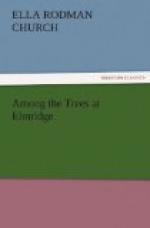“But isn’t it a shame,” said Clara, “to spoil the maple-sugar by making the trees into chairs and things?”
“You would not think so,” replied her governess, “if you needed the ‘chairs and things’ more than you need the sugar. But the supply of trees seems to be sufficient for both purposes.”
“Does the sugar come right out of the tree when people tap on it with a hammer?” asked Edith, whose ideas of sugar-making were rather crude.
“You blessed baby!” cried Malcolm, with a shout of laughter. Let’s take our hammers and go after some maple-sugar right away.”
“No, Edie,” said Miss Harson as she took her much-loved little pupil on her lap; “we’ll stay at home and learn just how the sugar is made. To tap a tree, dear, means to make cuts in the trunk for the sap to flow out, and in the sugar-maple this sap is more like water than sugar. From the middle of February to the second week in March, according to the warmth or the coldness of the locality, is the time for tapping the trees; and when the holes are bored, spouts of elder or sumac from which the pith has been taken are put into them at one end, while the other goes down to the bucket which receives the sap. ’Several holes are so bored that their spouts shall lead to the same bucket, and high enough to allow the bucket to hang two or three feet from the ground, to prevent leaves and dirt from being blown in.’ The next thing is to boil the sap, and this is done in great iron kettles, over immense wood-fires, out there among the trees, with plenty of snow on the ground, and only two or three rude little cabins for the men and boys to sleep in. This is called ‘the sugar-camp,’ and the sap-season lasts five or six weeks.”
“And why is it boiled?”
“Boiling drives the water off in vapor, and leaves the sugar behind in the pot.”
“And do they stay in the woods there all the time?” asked Malcolm, with great interest. “What lots of fun they must have, with the big fires and the snow and as much maple-sugar as ever they want to eat! I’d like to stay in a sugar-camp in the woods.”
[Illustration: MAKING MAPLE SUGAR.]




